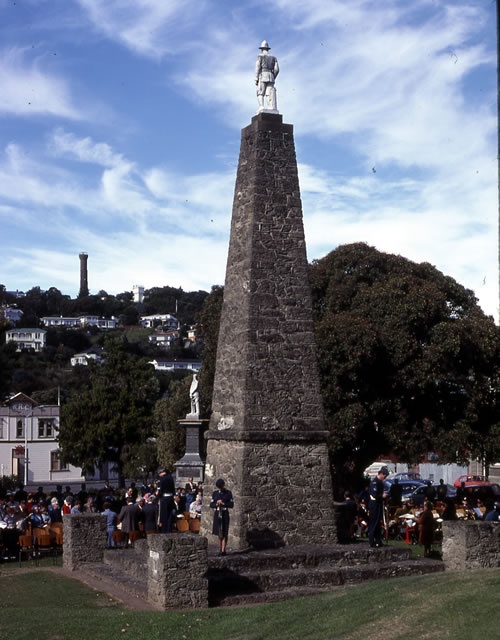
Whanganui Māori war memorial. The main image is from c. 1986, the other images from 2013.
Whanganui’s memorial to Māori who served in the First World War stands in Moutoa Gardens (Pākaitore), Whanganui. Its central feature is an obelisk of shellrock almost 10 metres high on a stepped base. The obelisk is surmounted by a statue of a soldier.
After the war, Whanganui Māori decided to use remaining money raised by the local branch of the Lady Liverpool Maori Soldiers’ Fund to erect a memorial to Māori participation in the war. The City Council set aside land at Moutoa Gardens for the memorial and additional funds were provided by local Māori and Pākehā and by the central government. Construction of the memorial began in late 1924 and it was unveiled on Anzac Day 1925.
The statue on top of the memorial is of Herewini Whakarua, a soldier from Waitōtara in South Taranaki who enlisted in 1914 and served overseas until his death from combat wounds in January 1918. The statue was commissioned privately for the family urupā, but the whānau agreed to it being placed on the memorial instead.
At the corners of the memorial are low pillars with the names of places where Māori soldiers served: Egypt, Gallipoli, France and Belgium. Earth from these battlefields (obtained with the help of the Imperial War Graves Commission) was placed in the pillars but later stolen. A ceremony to place the Belgian soil in the memorial was held on 20 May 1925 and an official photograph was taken to send to the Belgian government.
There was a large attendance at the memorial’s unveiling ceremony on Anzac Day 1925, when Sir Māui Pōmare spoke on behalf of the government and emphasised the fighting prowess of Māori soldiers. From 1926, a separate Anzac Day service at the Māori memorial became an annual tradition, complementing Whanganui’s main Anzac Day ceremony.
The memorial’s inscriptions in English and Māori express pride in the achievements of Māori soldiers in the First World War. There is also a panel commemorating 17 Māori from Whanganui and neighbouring districts who died during the war or of wounds they had received.
Inscriptions
The inscriptions on the main panel in Māori and English are:
1914—1918 / Ko tenei tohu / he mea whakaara na nga / iwi Maori o Whanganui / hei whakamaharatanga mo / te Pakanga Nui, i tuatahi / ai te whakawhiti ki era / whenua o tetahi ropu / hoia Maori motuhake, ki / te whawhai. I nga parekura / o Karipori, o Wiwi me / Peretiamu, i aranga i a / ratou te ingoa o te iwi / Maori. I nga tini parepare / o te riri, i whawhai tahi / ratou i te taha o nga / hoia o Ingarangi me nga / Koroni mo te Atua, mo te / Kingi me te Emepaea. Kei / te moe tahi o ratou / tupapaku me nga tupapaku / o nga iwi i whakakotahi, / a, he rite te tukunga i o / ratou tinana ki te mate / kia mau ai te ora, te pono / me te aroha ki te ao katoa.
1914—1918 / This memorial / was erected by the Maori / people of the Whanganui / district to commemorate / the Great War, during / which Maori soldiers for / the first time in history, / went over-seas on active / service as a complete / military unit. On the / battlefields of Gallipoli, / France and Flanders, they / added to the traditions / of their race. Along the / far flung battle line, they / fought side by side with / the Home and Overseas / forces for God, King and / Empire. With the immortal / dead of all Allied forces, / they made the supreme / sacrifice that liberty, / justice and goodwill might / be preserved throughout / the world.
Further information
- Ewan Morris, ‘“Kia Mau ai te Ora, te Pono me te Aroha ki te Ao Katoa”: The Māori First World War Memorial at Whanganui’, Turnbull Library Record, vol. 46, 2014, pp. 62-79.
- These reports from the Wanganui Chronicle on 16 March 2013, 1 April 2013 and 19 July 2014 refer to the restoration of the memorial and saving the statue.






Community contributions